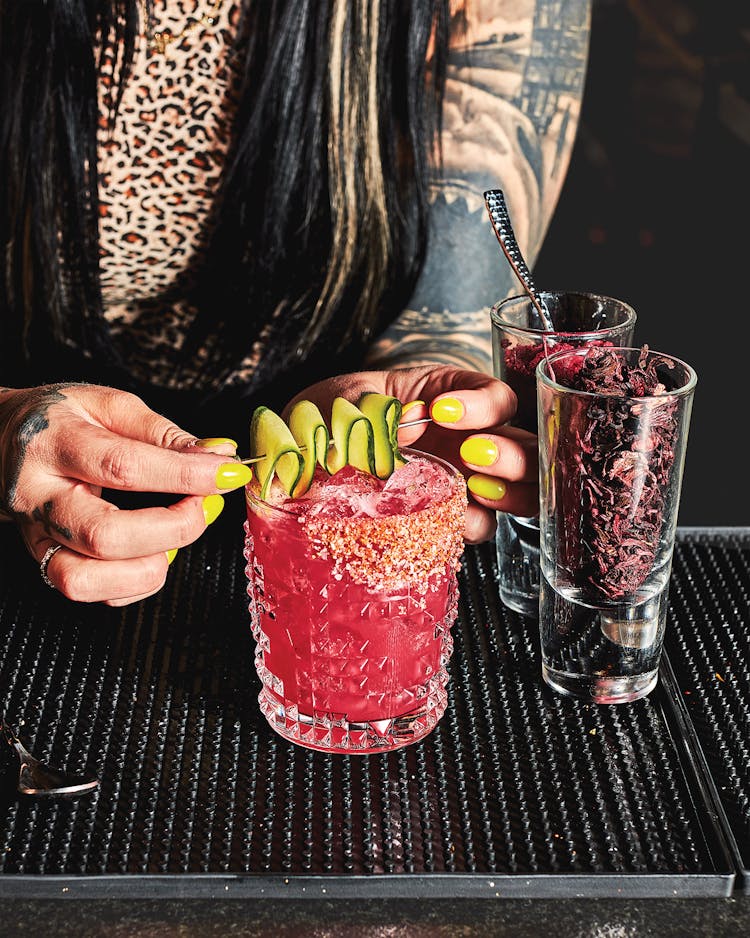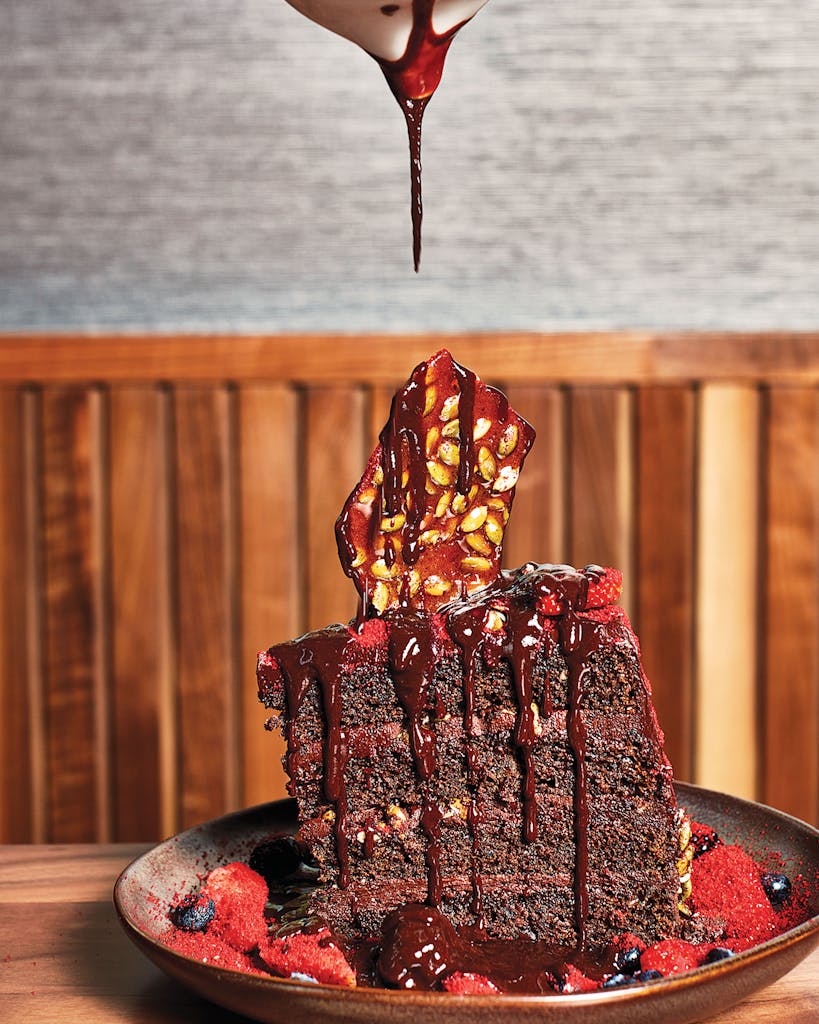Often when I visit an imposing, stylishly designed new restaurant, I find myself wondering as much about its cost as its cuisine. That was certainly the case when I arrived at the Mexican, which is located a few miles northwest of downtown Dallas in a fabulous building the size of three basketball courts. When my friends joined me, the hostess led us to a table in the main dining area, pointing out as we walked such features as the three private dining rooms (the largest accommodating fifty people), decorated with commissioned artwork. She gestured toward the well-ventilated
cigar room, then mentioned that if we had an interest in agave spirits, the tequila sommelier could be alerted (the restaurant’s four hundred selections range from amber-hued, barrel-aged añejos to clear, charcoal-filtered cristalinos). Waiters in light-gray vests bustled about, and customers waved and blew kisses across the room while Latin lounge music blared (as music sadly does these days in too many trendy dining venues). With its glowing table lamps and chairs upholstered in jewel-toned velvet, the space, which seats 320, felt less like a restaurant than a gracious home—on a monumental scale.
The cost of the build-out could be “getting close to ten million dollars,” said my architect friend over the phone, as he clicked his way through the photos on the Mexican’s website. He has been designing restaurants for more than twenty years, and I had called to get his assessment of the 15,000-square-foot place. Together we looked at photos of the intricate walnut ceiling treatments and smart black-and-white tile floors. “In today’s prices,” he said, “a nice restaurant is going to run five hundred dollars a square foot, and that’s just construction”—we were already at $7.5 million—“not including soft costs like architecture, licensing fees, permitting, consultants, engineers.” He continued: “And then there’s art, tableware.” The Mexican is undoubtedly one of the most lavish restaurants in Texas.


“Our goal is to bring the best of Mexico to Dallas,” said Monterrey-born and ⎯raised entrepreneur Roberto González Alcalá, the restaurant’s deeply involved chief investor, when I spoke with him after my visit. He’s not a newcomer to the city. “I have been traveling to Dallas for many years,” he said. It turns out that his late father was a longtime chairman of corporate giant Gruma, one of the world’s largest producers of tortillas. A branch of a Gruma subsidiary, Mission, is based in Irving. (González Alcalá was himself Gruma Mexico’s CEO at one point but is no longer involved in the company’s management.) Those repeated visits introduced him to the dining scene, and to something that bothered him. “Dallas has very good Mexican restaurants but not many at the high end,” he observed, an opinion that I happen to share.
Long story short, he now heads a group of investors and restaurant operators dedicated to doing something about that deficiency. They also harbor another motive. Said González Alcalá, “When people read and hear bad stuff about Mexico in the news again and again, they forget the many good things about our country.” He and his associates intend the Mexican to be nothing less than an ambassador for the richness and sophistication of Mexican culture.
Settling in, my friends and I sized up the menu, which struck me as very much the kind you’d find in an upscale steak and seafood house frequented by successful Mexican executives. The restaurant’s chef de cuisine, Rodrigo Lomeli, made a name for himself at exactly such a place, La Nacional, in Monterrey. (He now lives in Dallas and is busy learning English.) Its executive chef is Oklahoman Christopher Tunnel, formerly with the Omni Los Angeles Hotel and the North Italia restaurant chain.

After some debate, we decided on the chicharrón de ribeye starter: a cubed lean Wagyu steak, lightly breaded (if a tad tough) and seasoned with Monterrey’s popular spicy-tart PiquinLimon sauce. (In Mexico, “chicharrón” can mean fried pork rinds or, simply, something fried and crunchy.) We folded the bits of steak into warm, pliable house-made corn tortillas and added a dollop of creamy guacamole, which resulted in decidedly elegant tacos. (In the menu’s tacos section, offerings start at three for $17, one of the restaurant’s comparatively affordable options.)
Hamachi sashimi came next, the overlapping slices of pristine yellowtail cleverly arranged in the shape of a fish, with a V-shaped tail at one end and a pert nose at the other. It was pleasant, but I did wish for a bit more of the main seasoning, mandarin-yuzu juice scented with truffle oil (the latter, thankfully deployed with a light hand, shows up in a lot of dishes here).
Our heartier next course, enchiladas de camarón, featured plump Gulf shrimp that had been sautéed in white wine and tucked into tortillas along with mild Oaxaca cheese and grilled onions. On top was a light, fresh salsa ranchera. Like many of Lomeli’s sauces, it contained chile pequin, a fiery pepper widely used in Mexico and prized for its subtly fruity flavor. He uses it with discretion in this dish, but that’s not always the case. When your waiter tells you something is very spicy, believe it.
Moving along, we contemplated sharing the 33-ounce tomahawk ribeye, for $135, but I can’t imagine it would have been better than our 9-ounce boneless Wagyu ribeye ($52), grilled over oak and sharply smoky mesquite briquettes. It arrived alongside a huge, primitive-looking roasted marrow bone and an equally hulking head of roasted garlic. When our waiter finished extracting the essence of each, we spread it on the steak like butter and added dashes of a lightly vinegary sauce of red chile pequin and the milder chile japonés. Every bite was carnivore heaven.
It will be interesting to return to the Mexican in six to twelve months and see how the partners’ ambitious experiment has played out.
“I’ve never seen sides quite like these,” I thought to myself as I blithely over-ordered one after another. Lobster elote—creamed sweet corn with nice chunks of the crustacean—was so insanely rich in its cheesy sauce suffused with roasted habaneros and red bell peppers that I could eat only a tiny amount. Ditto the mashed potatoes swirled into a meaty, russet-hued gravy made with chorizo and Mexican Manchego cheese.
Our vegetable dishes were considerably lighter. We loved the char-roasted cauliflower tossed with chopped pistachios and avocado in a truffle-habanero
dressing. In fact, it was the table favorite until the dark red beets arrived, which were so sweet they didn’t need the sauce that came alongside, a cousin of aioli kicked up with Dijon mustard and a dash of Tabasco. When we asked about the beet preparation, our waiter whipped out his phone and showed us a video he’d shot earlier (answer: parboiled and roasted).

The desserts were just as over-the-top as we expected. The chocolate cake was four tall layers of sponge thickly iced with ganache, given a table-side pour-over of more ganache, and crowned with chunky pepita brittle. The
cuatro leches cake upped the ante with rompope (Latin American eggnog) as the fourth milk, the presentation capped with a fluffy whipped cream scented with vanilla liqueur. We decided to pass on the menu of nightcaps and dessert wines but were glad to see digestifs listed, just in case.
It will be interesting to return to the Mexican in six to twelve months and see how the partners’ ambitious experiment has played out. Will members of the crowd that swarms pricey new restaurants add it to their regular rotation? Will it get the stamp of approval for wedding rehearsal dinners and corporate parties? For convention events? Will regular folks try it out for enchiladas and tacos (expensive but not prohibitively so)? Or will everybody visit once and then go back to more-modest venues for Mexican cuisine? I look forward to returning to see if Lomeli’s menu is sticking to its initial flavor profiles or getting subtly Dallas-ized. The Mexican is certainly a pretty place—and, for all its high prices, a whole lot cheaper than a trip to Monterrey.
The Mexican
1401 Turtle Creek Blvd., Dallas
214-210-5700
D Tue–Sat.
$$$$
Opened March 11, 2022
This article originally appeared in the June 2022 issue of Texas Monthly with the headline “Mexican Ambassador.” Subscribe today.

